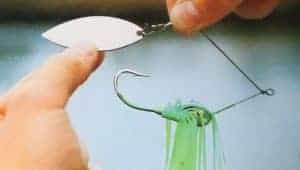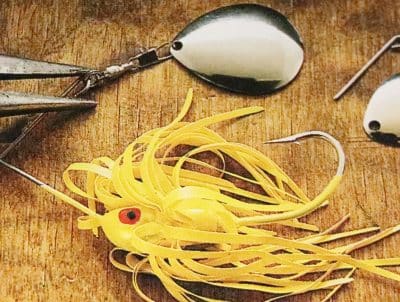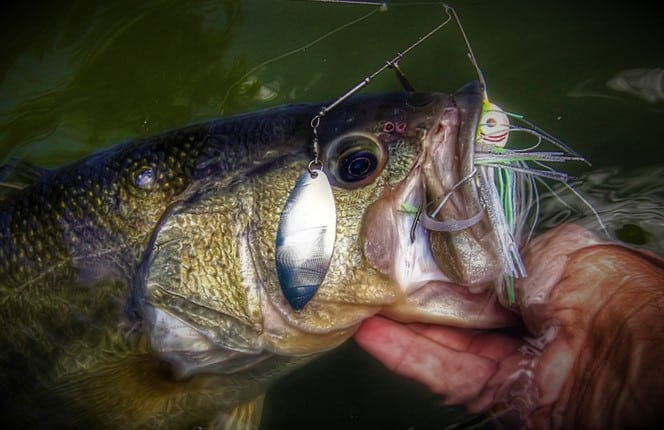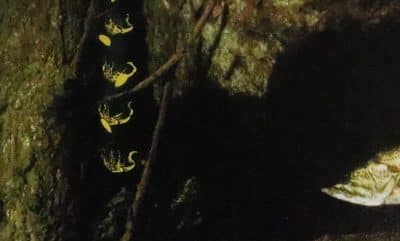Spinnerbaits were designed to solve the problems encountered by southern bass anglers. Their fishing reservoirs were all strewn with timber and brush. Standard and weight forward spinners would easily snag on debris. With a little bit of ingenuity fisherman came up with the iconic spinnerbait.
Fishing With Spinnerbaits For Bass
Spinnerbait Design
The shaft of a spinnerbait is bent in the shape of an open safety pin. The bent shaft prevents weeds and branches from fouling the hook and blade.
You wouldn’t think this design would be successful, but they work better than most other weedless lures. Since the entire hook is exposed you’ll be much more likely to hook a fish.
When to Use Spinnerbaits?
Many fishermen use spinnerbaits to locate fish in shallow water. You can cover a lot of water quickly without worrying about snags. While moving fast, the flash and vibration draw fish in.
Whenever I need to cover a lot of water fast I’ll throw out my favorite spinnerbait. Normally I’ll throw a flashy Booyah Super Shad or basic Strike King Finesse KVD Spinnerbait. They’ll quickly draw strikes from the most aggressive fish in the area.
High aggression typically leads to a larger catch. Even if the fish doesn’t take the lure they’ll often follow revealing its location. Then you can use a slow rolling technique with a less flashly lure to catch it.
Choosing The Best Spinnerbait For Bass
When selecting spinnerbaits first consider the length of the upper arm, the thickness of the shaft and the shape of the head. In most situations use a spinnerbait with an upper arm long enough so that the blade rides above the hook point.
Shorter arm models work best when using the “helicoptering” technique. Booyah’s Pond Magic Spinnerbait is the perfect example. Try helicoptering it alongside vertical cover.
It works perfectly next to submerged trees and other debris. If the arm is too short, it won’t protect the hook from snags or keep the hook from rolling.
You need enough stability to provide a stable foundation. With too long of an arm you’ll have issues hooking fish. Most bites will be on the spinnerbaits blade.
Look for a thin wire shaft to get the most wiggle from your blade. Thin wire will also make catching fish much easier. It should collapse on the strike guaranteeing a catch.
With most well known manufacturers you won’t have to worry about wire thickness. The only time you need to worry is with cheap chinese models you find on eBay/amazon.
In timber you’re going to want to find a thicker wire shaft. With a thick shaft brush will deflect off underwater timber and branches.
Look for a pointed or bullet shaped head molded to the lures lower shaft. Streamlined heads will help the lure snake through thick weeds and undergrowth. You should also consider options that come with a detachable free swinging jig instead of a head. It will be worse in the weeds, but much better at hooking fish.
How Many Spinnerbait Blades do You Need?
There are a ton of different blade options you can choose from. The most popular choices are single-blade, tandem-blade and twin blad models. Single-blade types will produces the strongest vibration making them an extremely versatile choice.
Tandem blades offer more water resistance. Most tandem blade lures stay shallower than other options and are effective for bulging the surface. Twin-blade lures are best with heavy weeds. The dual blades protect the hook from catching on heavy cover.
How To Fish With a SpinnerBait
Many professional bass anglers rely heavily on spinnerbaits. They’re extremely versatile lures working in a wide range of waters. You can use it in a broad range of fishing situations. Adjust your reel speed to suit your individual fishing needs.
- Bottom: Reeling slowly will make your lure fall straight down to the bottom. You can creep it along the bottom waiting for large bass.
- Below Surface: By increasing your speed a little bit you can pull the lure a few feet below the surface. With its medium speed reel this is the perfect technique for beginner fisherman.
- Bulging Out: Increase your speed to make the lure quickly bulge out of the waters surface. Crappie fisherman even troll with spinnerbaits when fishing in open water.
Try and experiment with different retrieves until you find one that works best for the conditions. Overtime fish will let you know which reel they like the most.
Properly Tuning Your Lure
A properly tuned spinnerbait shouldn’t twist when retrieved. You should be able to tie it directly to your line with no foul effects.
Unlike other lures a snap or swivel will just increase the chance of your lure tangling in your line. If you have a coil of wire for an eye your line may get wedged in the coil.
Whenever this happens you’re going to need to cut the line and retie. Products with an open slot for an eye shouldn’t catch on the line.
How To Feel Your Bites
Due to their somewhat complicated design fisherman have a hard time feeling their bites. It really is hard to recognize your strikes.
Fish commonly strike with only a gentle nudge and don’t completely commit. Whenever you detect a slight pause make sure you set your hook.
Wearing polarized sunglasses should help you spot incoming fish. This is especially true when working the top of clear water.
Tip Your Spinnerbait With Meat
One old time fishing secret is tipping your bait with pieces of meat. Old timers like to tip their hook with a pork strip, but live bait will work as well.
Most fisherman choose either a minnow or nightcrawlers. Some panfish anglers remove the plastic grub tails and subsitute live grubs, worms or pieces of shrimp.
What Can You Catch With a Spinnerbait?
While spinnerbaits were designed primarily for largemouth bass they can catch a wide variety of fish. They also work well for smallmouth, spotted bass, crappies, sunfish, northern pike pickeral and muskies. Change up your size for the type of fish you’re looking for.
- 1/32-1/8 Ounce: Panfish
- 1/8-3/8 Ounce: Smallmouth and Spotted Bass
- 1/4 to 1 Ounce: Largemouths and Pickerel
- Up to 3 Oz: Muskies and Northerns
Spinnerbait Fishing Tips
- Helicopter a spinnerbait alongside vertical cover. This works in areas with submerged timber and natural drop offs. Make sure you keep your line taut to detect any change in motion. Helicoptering works best whenever fish are drawn to cover. It’s perfect for early spring and late fall weather. Try shortening the upper arm to make the blade helicopter more. If you go to short you’ll have issues snagging on weeds.

- Cast your spinnerbait out past dense cover then slowly retrieve. Make sure you guide your line so that the lure bumps the cover. The sudden break in blade rotation has been known to promote strikes. Work the shady side of cover for the most strikes.
- Learn how to assemble your own spinnerbaits from different components. It’s one of the easiest lures to assemble and will change up your game. There’s a ton of different options available from basic setups to advanced customizations.
- Customize your blade and hook to maximize its effectiveness. Try replacing the standard Colorado blade with a much larger blade. A larger blade has more flash and can be retrieved faster. You can also change up your hook to help with snags.



